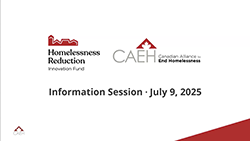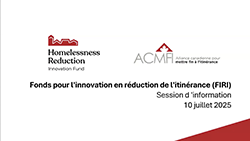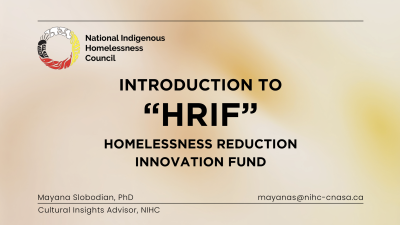![]()

This fund provides one-time grants for projects aimed at achieving measurable reductions in homelessness.


More about the fund
HRIF grants will be distributed to communities for targeted, data-informed projects that measurably reduce homelessness. CAEH will offer one-on-one guidance and coaching to communities on their initiatives and share successful approaches with other communities across the country. The National Indigenous Homelessness Council may provide project support.
The Homelessness Reduction Innovation Fund is part of the federal government’s commitment to Reaching Home: Canada’s Homelessness Strategy, as announced in Budget 2024.

Eligibility
An Expression of Interest (EOI) will be used to assess eligibility and project suitability for HRIF. Based on EOI responses, communities may be invited to complete an application.
To be eligible for the Homelessness Reduction Innovation Fund (HRIF), communities (outside Quebec1) must be:
- The Reaching Home Community Entity (CE) for the Designated Community (DC) stream, and/or
- the Indigenous Homelessness (IH) stream, and/or
- the Territorial Homelessness (TH) stream, and/or
- the community lead organization participating in Built for Zero – Canada (BFZ-C).
If your organization is not a Community Entity or the community lead for BFZ-C in your community, please reach out to them to collaborate on a project.
If your community has both a CE for the Designated Community stream and community lead with BFZ-C, and these are not the same organization, please collaborate on one project with one organization taking the lead.
If you are an Indigenous-led organization that is not the Indigenous Homelessness Community Entity (IH CE), please reach out to them or the Designated Community if no IH CE exists.

Communities must also be able to demonstrate:
- An improvement project aimed at reducing homelessness by increasing move-ins to housing or decreasing inflow to homelessness for the chosen target population.
- Quality By-Name Data (QBND) for their project’s target population(s) (confirmed by CAEH). Eligible target populations for the purposes of HRIF projects include:
-
- Chronic Homelessness (including the following chronic sub-populations: single adults, youth, families, Indigenous)
-
- Veteran Homelessness
-
- Unsheltered Homelessness
Although the above priority populations have been identified for this round of HRIF, projects may aim to reduce All Homelessness if communities are confident in their ability to achieve measurable reductions and are able to confirm Quality By-Name Data (QBND) with CAEH for All Homelessness before application submission.
Communities that do not yet meet the eligibility criteria outlined above are still invited to complete the Expression of Interest. The intention of the HRIF is to support communities’ efforts to make measurable reductions in homelessness. Where eligibility criteria are not yet met, applicants are encouraged to provide context in the fields provided in the Expression of Interest. While applicants must meet eligibility to receive funding, projects that don’t yet qualify may receive support to strengthen future applications. Your Expression of Interest will be shared with CAEH and may be shared with the National Indigenous Homelessness Council (NIHC).
* Organizations in Quebec are not eligible to apply for the Homelessness Reduction Innovation Fund. Housing, Infrastructure and Communities Canada will collaborate with the Government of Quebec to put in place this funding in recognition of the jurisdictions and priorities of both governments in the prevention and reduction of homelessness. Questions can be directed to Housing, Infrastructure and Communities Canada at: reachinghomeinfo-infoversunchezsoi@infc.gc.ca.
Data Sharing
CAEH will share learnings and successes from funded projects with other communities across the country . Funded communities commit to sharing their learnings, outcomes, and project data with CAEH. Communities must be able and willing to share QBND with CAEH monthly (at minimum).
Key Dates

July 14, 2025 – Expression of Interest submission period opens
August 15, 2025 – Expression of Interest submission period closes at 4 pm ET.
September 2, 2025 – Invitations to complete an application will be extended. Communities will also be informed if they were not selected to receive an application.
September 26, 2025 – Applications due by 4 pm ET.
October 24, 2025 – Applicants will be informed of decision.
Target of early 2026 – Expression of Interest submission period opens for next round of HRIF.
Stay tuned for what the communities accomplish
If you wish to receive correspondence, newsletters and updates from CAEH or one of our Allied Networks, please join a mailing list below.
Expressions of Interest
The Expression of Interest submission period is now closed. Sign up to our list to receive ongoing information about HRIF, including the next call for Expressions of Interest in early 2026.
Past information sessions recordings
 |
|
|---|---|
 |
|
 |
Indigenous Led Community Organizations & IHCEs |
About us
The Canadian Alliance to End Homelessness works to prevent and end homelessness by helping to build effective community response systems and campaigning for the policy changes needed for everyone to have a place to call home.
